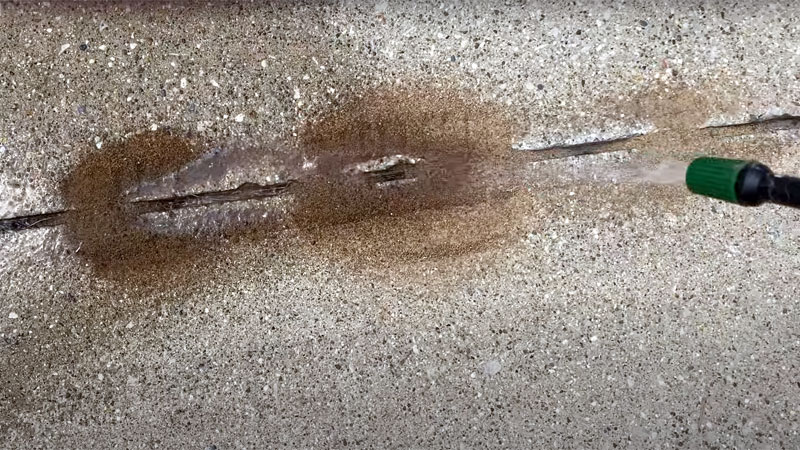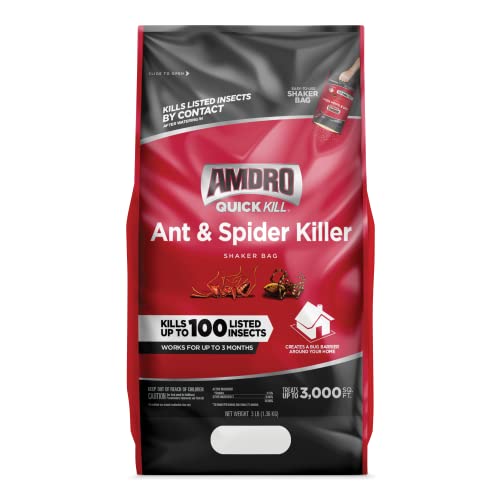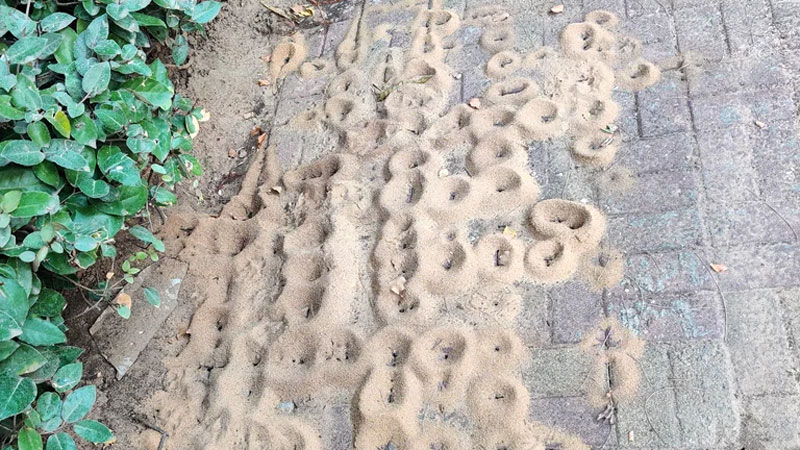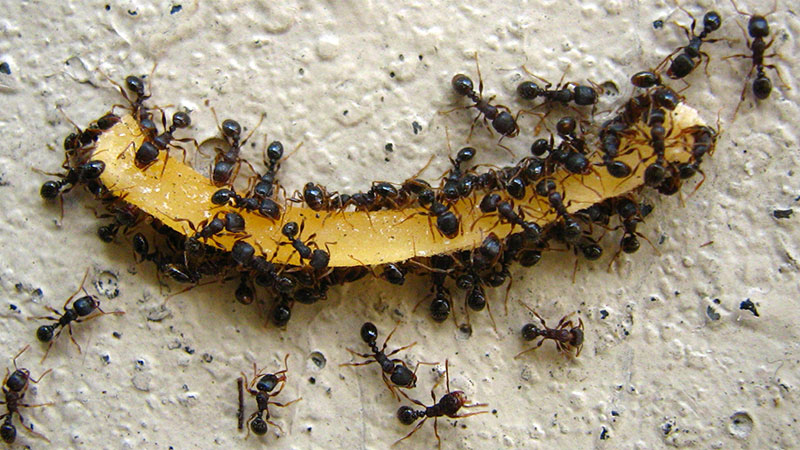There are 14,000 species of ants currently classified and possibly 8,000 more suspected species out there, so it’s no surprise we talk a lot about these critters. Pavement ants (AKA concrete ants) are an entire genus called Tetramorium that contains 520 species. Of these, you’ll most likely encounter Tetramorium caespitum and Tetramorium immigrans.
Getting rid of pavement ants can be just as tricky as dealing with Argentine ants, and for the same reason. However, it’s not impossible to these common sugar ants with a little careful planning. Let’s look at some effective techniques, as well as get to know these critters a little better.
How to Get Rid of Pavement Ants
Eliminating a pavement ant infestation is tricky, not because they’re particularly hard to kill, but because they can put rabbits to shame. When a lot of workers are suddenly killed, the colony goes on high alert.
The queens respond by laying eggs more rapidly than usual. Thus, killing pavement ants without a little planning can seriously backfire.
When to Use a Pavement Ant Treatment that Alarms the Colony
While alarming the colony can lead to a population explosion, that doesn’t mean you should never use fast kill methods. The trick is knowing when you need a stopgap while waiting for a more effective method to kill the queens.
For example, these gals are all over your kitchen floor, it helps to kill the foragers quickly.
With this in mind, let’s look at how to kill pavement ants, in order of highest to lowest risk. We’ll also cover where each method can be used and when it’s best to use them.
#1 – Boil Them
One of the fastest and most lethal ways of killing pavement ants under sidewalks, patios, and other outdoor surfaces is to use boiling water. Note that this is considered a high risk option for three reasons:
- It causes the nest to panic and surviving queen ants will begin laying eggs in overdrive.
- There’s a risk of scalding yourself.
- The boiling water can kill any plants it comes in contact with, including their roots.
That said, this method can be a great way to reduce a pavement ant population long enough while you set up bait stations or other slower methods. An ideal area to use this trick is on cracks in or between concrete slabs.
Simply locate one (or preferably several) of the nest entrances and pour a couple gallons of boiling water directly onto it. Don’t just dump, however, as this will cause splashing. Instead, pour slowly from just above the entrance.
As the water soaks into the soil, it will kill any ants it hits instantly, slowly becoming less effective as the it cools.
#2 – Insecticides
Insecticides come in three forms which can have varying degrees of risk and benefits. In most cases, all three can be used inside and/or outside (check the label to be sure) Let’s look at each type of ant killer on its own.
Baits
Whether you use a homemade ant bait or go with a liquid or powder ant bait, these are slower acting but also some of the most effective insecticides available. Simply use a bait station or sprinkle the bait around known nest entrances.
Because it’s slow acting, the workers will have time to take it back to the nest and share it with the queens and other workers, poisoning all of them. You can also make homemade pavement ant bait using equal parts borax and peanut butter and/or jelly.
Benefits:
- Can be safer when used in bait stations
- High success rate
- Won’t alarm the colony
Drawbacks:
- Slow acting (on purpose)
- Toxic if consumed by humans or pets
- Attracts & Kills – Kills common household ants including acrobat, crazy,...
- Kills the Ants You See & the Ones You Don't – As worker ants discover the...
- Works Fast – You should see a significant decrease in the number of ants...
Dusts
Insecticidal dusts like Amdro are a powder form of toxin which is sprinkled around the colony entrances. As the ants walk over it, the insecticide clings to them and is consumed when they groom.
Benefits:
- Decent success rate
- Fast-acting
- Won’t alarm the colony
Drawbacks:
- Can also kill beneficial insects on contact
- Toxic to humans and pets if consumed
- Washes away easily
Sprays
Insecticidal sprays like Raid are some of the most popular but also the least useful of the methods. Some must be sprayed directly on the ants while others will leave a residue for up to three months.
Benefits:
- Fast-acting
- Won’t alarm the colony
Drawbacks:
- Contact killer
- Leaves a toxic residue that could harm children and pets
- Keep your home or office pest free without leaving an unpleasant chemical scent...
- Insecticide with residual action kills ants and roaches on contact and keeps...
- Aerosol spray can enables easy application over a broad area.
Related: Can Salt Be Used to Kill Ants?
#3 – Sticky Traps
You are likely very familiar with sticky traps already. These are the same as fly strips and can be a commercial product or simply a piece of very sticky tape laying smooth side down.
While these traps can be used to kill ants, they have no effect on the colony itself. Instead, it’s best to use this method to create barriers, protecting portions of the garden or home and funneling the ants to a spot you can use other methods.
- READY TO USE: Catchmaster Insect, Cricket, Cockroach and Spider glue traps are...
- YEAR ROUND PROTECTION: Catchmaster spider traps for inside your home are safe,...
- INDOOR USE: Observe pest infestation with Catchmaster glue traps. An easy way to...
#4 – Diatomaceous Earth
One of our favorite bug killers, food-grade diatomaceous earth (DE for short) is the crushed fossils of microscopic diatoms. When ants (or other insects and arachnids) crawl over it, DE’s sharp edges lacerate the protective waxy coating of their exoskeleton and they soon die of dehydration.
While DE only works on contact and is easily washed away, it’s safe for use around humans (it might irritate the paws of pets, however) and won’t alarm the colony. Sprinkle it around colony entrances or along ant trails to make foraging harder and place ant baits near those same entrances so the ants can’t avoid death.
Just remember, this method won’t kill queens, so it’s best to use it in conjunction with some ant bait for pavement ants.
How to Kill Pavement Ants Outside
All of the methods we’ve mentioned thus far work on both indoor and outdoor infestations. However, there’s one method that won’t work indoors unless you live in a greenhouse or have a conservatory. Let’s take a moment to look at that method, as well as an extra tip to keep these critters from coming back.
Complimentary Gardening
Plant alliums (ex: garlic), cloves, lavender, marigolds, peppermint, rosemary, or turmeric around your garden or as borders along paths. Not only are most of these plants edible, their scents overpower that of the ants’ scent trails, causing them to avoid the area.
Even better, alliums and marigolds attract several natural predators that will happily hunt the ants for a tasty snack.
Bonus Prevention Tip
Pavement ants love building their nest underneath protective surfaces. Therefore, it’s important to reseal your concrete driveway or sidewalk regularly. Also locate and seal any foundation or garage cracks.
Getting to Know Pavement Ants
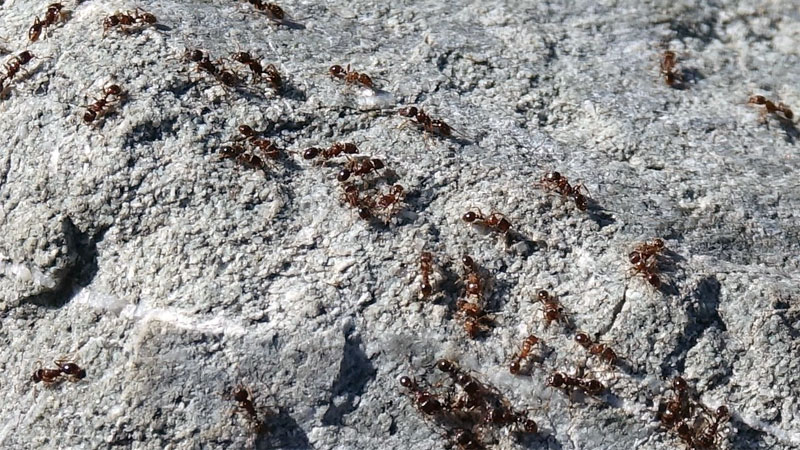
It’s believed that Tetramorium immigrans was accidentally introduced to the US in the 1800s. Since then, it’s become one of the most common species in the country. This entire genus varies greatly, with both species and subspecies often being identified by physical differences the average person would likely never see on critters only 1/16″ to 1/8″ inches long.
As a general rule, pavement ants tend to be brown to black in coloration. Their abdomens are usually oval, with a stinger at the tip that’s used for both scent marking and defense.
Pavement Ant Colonies
Tetramorium spp. get their common name from a habit of building colonies under and inside of rocks, sidewalks, and masonry. Their entrance mounds can often be spotted poking out of cracks.
They can become problematic in both homes and gardens, in no small part due to the sheer size of these colonies.
A single colony can have between 3,000 and 10,000 individual ants, as well as multiple queens. Unlike many ants, the workers in this genus can live for up to five years, further adding to the rapid growth rate.
For comparison, fire ants typically live about 5 weeks.
See Also: 12 Different Kinds of Ant Mounds
Do Pavement Ants Bite or Sting?
Pavement ants tend to be quite docile and won’t bite humans. However, they can sting when threatened. The sting is very mild, although it may result in an allergic reaction in sensitive individuals.
What Causes Pavement Ants to Come Inside Your Home?
Pavement ants, like many other critters, will find their way into your home while searching for food, water, and warmth. While they can invade your kitchen, they most often enter through cracks in the foundation.
Some more specific things that can invite pavement ants to your home and property include:
- Bug infestations, especially honeydew producing pests such as aphids.
- Compost or other dead organic matter
- Garbage or dirty dishes
- Pet food or birdseed
- Traces of greasy or sugary foods, such as spilled drinks or splatter from a grill.
Do Pavement Ants Live in Walls?
Once inside a home, pavement ants will form colonies in walls, floors, and other spaces. These colonies will usually be located where it’s warm, such as near hot water pipes or in insulation. Similar to clover mites, they can also occupy the cracks in concrete or masonry walls.
Can Pavement Ants Cause Structural Damage?
Thankfully, pavement ant colonies won’t cause any structural damage, although the presence of a large colony can cause enough of a mess that this may feel like a very small mercy. However, we should probably note one special instance where (minor) damage may occur.
When pavement ants try building under a sand-set patio, they’ll begin excavating a lot of that sand. However, sand isn’t the most stable substrate out there (which is precisely why it’s sometimes used for walkways and patios). When enough of it has been removed, the tunnels will collapse.
Besides potentially killing some of the ants, this can result in the patio surface becoming uneven. The good news is that you can simply remove the surface masonry and relevel the substrate to repair the damage.
Pavement Ants vs Carpenter Ants
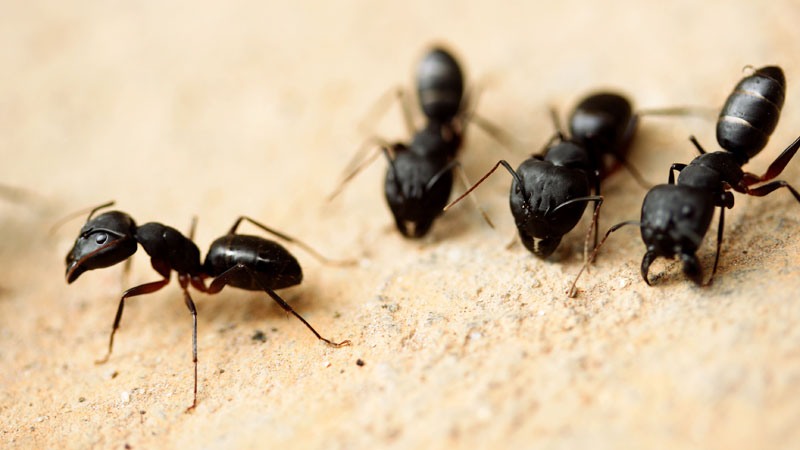
Size is the most notable difference between these two home invaders, with carpenter ants being up to three times the size of pavement ants. Carpenter ants are also often lighter colors, such as red or yellow (depending on the species).
If you manage to get a really close look under a magnifying glass, carpenter ants have one node between their thorax and abdomen while pavement ants have two.
Of course, the difference that matters most is that carpenter ants can be very destructive, while pavement ants are more nuisance than threat.
Read Also: 11 Common Ants Found in California
- How to Get Rid of Hawks - March 8, 2024
- How to Get Rid of Pill Bugs (Rolly Pollies) - March 1, 2024
- How to Get Rid of Groundhogs (Woodchucks) - February 5, 2024


